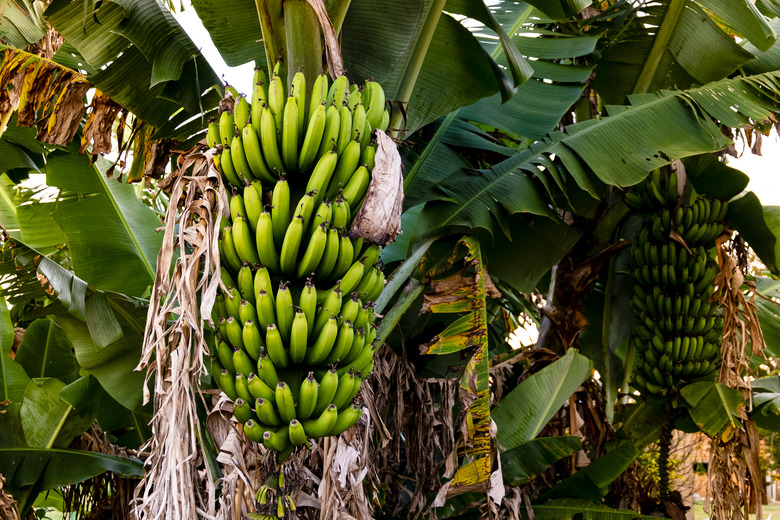How Long Until Banana Trees Yield Fruit?
We may receive a commission on purchases made from links.
You can pop over to the grocery store and get yourself a bunch of bananas, or you can plant your own and wait 18 months for it to flower. Yes, it takes 18 months, assuming a random freeze doesn't abort the growth process and start it all over. Once it flowers, it takes another few months for the banana plant to yield fruit.
If you can wait and you happen to live in U.S. Department of Agriculture plant hardiness zones 10 and 11, edible bananas (Musa acuminata) are easy to grow, but they do require optimal growing conditions. Note that bananas are not trees; they are the world's largest herb. They are actually quite fast-growing and will grace your landscape with dramatic leaves that unfurl to a length of up to 9 feet whether the plant fruits or not.
Tip
An edible banana plant takes about 18 months from planting to produce a flower and then another four to six months for the fruit to be ready to harvest.
Tips for Producing Banana Fruit
Tips for Producing Banana Fruit
Many gardeners grow bananas as ornamentals because growing them to produce banana fruit requires specific conditions. These include four important requirements: warmth, plenty of water, full sun and fertilizer. If you do want fruit, these requirements must be present for the full 18 months until the banana flowers. If a freeze occurs, the growth process will abort and start over. To provide them the warmth they crave, consider planting them next to a building or next to asphalt or concrete walkways, which warm the soil.
Bananas are heavy feeders. Plant them in rich, well-drained soil. Provide them with regular fertilizer, approximately 1/2 teaspoon of water-soluble, balanced fertilizer (for example, 10-15-10) per gallon of water each week. During cooler months or when there is less sun, reduce the frequency. In the winter when the plant is no longer actively growing, stop fertilizing.
Don't forget to water. The banana plant's enormous leaves require a lot of moisture to remain healthy. On the other hand, standing water can result in root rot, so ensure good drainage. Provide periodic, very deep waterings to leach the soil of salt, which can build up over time and of which bananas are particularly intolerant.
Harvesting Banana Fruit
Harvesting Banana Fruit
When the flower stalk emerges from the center of the banana plant's trunk — its pseudostem — it has started the flowering process called "shooting." In edible cultivars, the flower's ovaries quickly form into clusters of fruit, called "hands." For some species and cultivars bred specifically for ornamental use, such as Musa basjoo (USDA zones 6-10), you may see fruit develop if you live in a warm climate; however, these fruits are inedible. The average time from shooting to banana harvest is anywhere from 80 to 180 days.
Harvest bananas when they are still green but plump. You can either cut down the entire stalk, which should contain multiple hands — what you typically purchase in a market and think of as a banana "bunch" — or you can harvest the hands individually. If you don't harvest the entire stalk, check daily to look for rodent damage. Rodents have been known to eat the insides of the banana, leaving it to visually appear untouched.
Hang the stalk in a cool, dry place, perhaps a garage or basement. To encourage faster ripening, cover a bunch with a plastic bag, which keeps the ethylene gas naturally produced by bananas inside the bag.
References
- California Rare Fruit Growers: Banana
- NOLA.com: Banana Plants: Answers to All Your Questions About Care, Pruning and Harvesting Fruit
- Logee's Plants for Home & Garden: Cultural Information – Musa
- University of Florida IFAS Extension: Banana Growing in the Florida Home Landscape
- Missouri Botanical Garden: Musa acuminata
